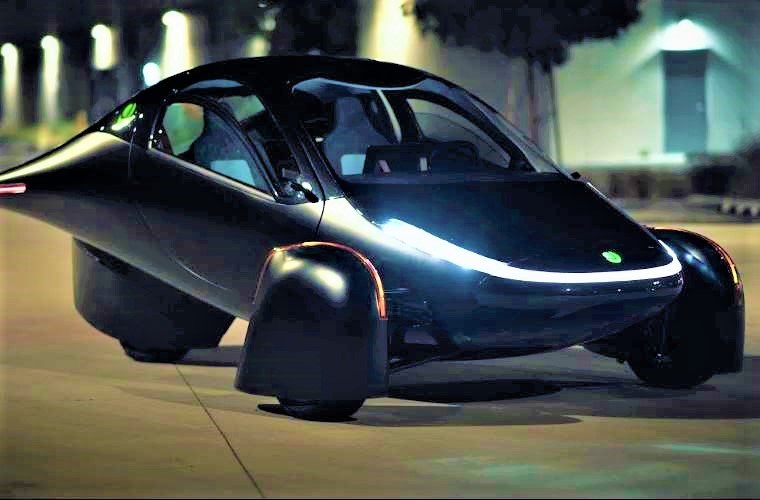After a decade and a half of design, planning, false starts, and rebirths, Aptera Motors of Southern California appears poised to finally deliver its first purely solar car later this year or early next year. It’s a massive step for the small vehicle manufacturing start-up and one that seems able to put the entire EV market on notice.
“We’ll be ramping our production with a new facility in San Diego and two more development vehicles in the coming weeks,” a recent video on the company’s site states, “working towards our goal to begin deliveries in 2021 and early 2022.”
Background: Founding Aptera’s Solar Car
Founded in 2006 by current Co-CEO’s Steve Fambro and Chris Anthony, Aptera (Greek for ‘wingless’) has seen many twists and turns along the road to 2021. Their first prototype was revealed way back in 2009, only to see the company go under two years later.
The duo reformed the company in 2019 as Aptera Motors, setting up shop in sunny southern California. A perfect place to test a solar-powered car, this particular area is also known for its high-tech marketplace. Even in this Silicon Valley-style, high-risk climate, the solar car company makes some incredibly lofty boasts.
“Aptera Motors delivers the world’s most technologically advanced solar electric vehicles (sEVs), made possible by breakthroughs in battery efficiency, aerodynamics, material science, and manufacturing,” they said in a recent press release. “It has the longest range of any production vehicle with 1,000 miles per charge and the ability to travel up to 46 miles a day on free power from its integrated solar panels. With only four key structural parts, Aptera’s unique body shape allows it to slip through the air using far less energy than other electric and hybrid vehicles on the road today.”
Analysis: Is Aptera’s Solar Car the Future of the EV Market?
On the surface, several assertions made about the teardrop-shaped solar car seem hard to believe, but a more in-depth look reveals most, if not all, of the claims have some merit.
For instance, with a reported 0.15 drag coefficient, a previous company release noted that “the sideview mirrors on a typical pickup truck have more aerodynamic drag than the WHOLE Aptera!” That same post notes their carbon fiber frame is four times as strong as steel while significantly lighter. With a total curb weight of just 1,800 pounds, the three-wheeled Aptera solar car has less than half the curb weight of the smallest Tesla, the model 3.
This reduced drag and weight dramatically improve the vehicle’s efficiency, giving it extended range and battery life. Also, by placing electric motors right on all three wheels, the vehicle nets even more power savings. A post from the company’s site explains the net effect of this motor design in conjunction with these efficiencies in more detail, stating that, “in combination with Aptera’s low-drag aerodynamics and lightweight construction, the high-torque in-wheel motors drop energy usage to less than 100 watt-hours per mile, four times lower than the average EV.”
If their numbers are right, that is a shockingly efficient use of power, especially if you live in a sunny locale.
“We use a lot less power to drive, so it takes a lot less power to charge, meaning that the addition of efficient solar panels can provide for the driving needs of most Americans, Aptera’s Media Team told The Debrief in an email.
A recent article by Auto Week noted just how significant that increase might be.
“Say you live in South Miami and get 10 hours of direct, glaring sunlight a day—700 watts times 10 hours is seven kWh. If this rig really does get 10 miles per kWh, that’d be good for 70 miles.”
Aside from increased efficiency, another benefit to a three-wheeled design instead of four keeps the Aptera classified as a motorcycle, making safety standards (some of which add more weight) lower than a car. Also, because its passengers are enclosed, they don’t have to wear a helmet.
“We developed a very unique resin infusion process many years ago,” their media team explained. “The composites are amazingly strong and when built correctly, they can really add to the safety and rigidity of the vehicle. This vehicle is built with a tub at the bottom, a top which we have coined “the spider”, plus two pieces to clam shell those together from the side.”
This combination of lightweight materials, efficient engines, and low drag help the solar car make better use of its three built-in solar panels, even more so than other notoriously energy stingy vehicles would be, should they try to copy the design.
“If you put our same solar package on a Prius,” co-founder Chris Anthony says on the site, “you could get maybe six or eight miles of charge range a day, which some people might find compelling if you have a really short commute. For most people, it wouldn’t be worth the expense of the solar. But when you only burn 100 watt-hours per mile, like the Aptera does, the same solar package can get you 40-plus miles a day of range.”
That range, Anthony points out, is significant for a very particular reason. “The average driver in the US drives 29 miles per day, so now for most American consumers, the Aptera is a vehicle you never have to plug into the wall to receive any charge.”
Anthony also notes another significant advantage for the average user. If you need more charge than the sun alone can provide, Aptera’s car can connect to a regular AC outlet. “Our vehicle is unique in that most electric cars, you can never really charge off a 110-volt outlet. It’s not enough power to charge a Tesla or Chevy Volt. But with our vehicle, the same outlet that you use to charge your cell phone can charge 130 miles of range per hour.”
Outlook: Here’s Hoping Aptera Can Deliver
Aptera’s claims are undoubtedly bold and may border a bit on the impossible. However, suppose Aptera can produce a vehicle that can go 40 or more miles a day on nothing but the sun’s power. In that case, they may be standing at the leading edge of an entirely new generation of vehicles that not only reduce the energy drawn from our country’s aging power grid but move those vehicles and their power demands off of the grid completely.
“We anticipate the first Aptera production vehicle to hit the road later this year, at the end of 2021,” Aptera told The Debrief.
Given the company’s latest set of announcements, their goal seems as intrepid as the concept of a solar vehicle itself.
Join us on Twitter or Facebook to weigh in and share your thoughts. You can also follow all the latest news and exciting feature content from The Debrief on Flipboard, Instagram, and don’t forget to subscribe to The Debrief YouTube Channel and check out The Official Debrief Podcast.

